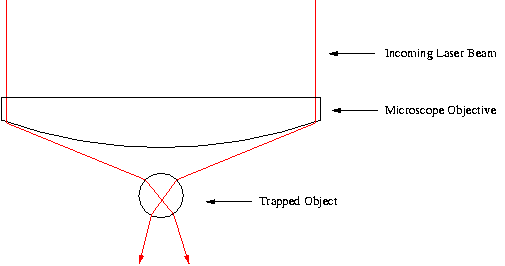|
About Optical Tweezers
What are Optical Tweezers?
Optical Tweezers is a tool that is capable of manipulating microscopic, transparent particles. There are many applications of optical tweezers in biology and chemistry.
How do Optical Tweezers Work?
The laser beam is brought to a small focus using a microscope objective. There are two forces involved with optical tweezers, the gradient force and the scattering force. The gradient force attracts the particle being trapped to the laser beam focus. This force is caused by a transfer of momentum from the photons in the laser beam to the particle. The scattering force pushes the particle away, in the direction the laser beam is traveling. The scattering force is caused mainly by the radiation pressure of the light. Trapping only occurs when the gradient force is greater then the scattering force.

The most momentum is transferred by the rays of light that come in at the steepest angle. The light that comes in at the steepest angle to the focus is the light along the edge of the objective. Therefore the part of the laser beam intensity along the side of the objective is most important in trapping.
My Optical Tweezers Setup

The optical tweezers setup that Peter and I built uses a readily available diode laser. The beam from the diode laser is highly divergent and elliptical in shape. For functional optical tweezers you need a collimated, non-diverging, and a circular beam. These two properties of the beam were corrected with various lenses. The laser operates at 780 nm, in the infrared part of the spectrum. This is important as infrared light is not absorbed readily by living organisms and will not harm them.
My Optical Tweezers Experiment
By redirecting the laser beam intensity to the edge of the objective much more efficient trapping should occur. I am attempting to create such a hollow beam laser by several different methods. One involves simply blocking the center of the beam. The disadvantage of this is that no laser intensity is redirected toward the edge of the beam. Another involves using a diffracting optic to create a hollow beam. This is similar to a method I looked at previously which used a fiber optic cable to create a hollow beam. However using the diffractive optic will allow me to collimate the laser beam, which I could not do with the fiber optic cable.
Home
|